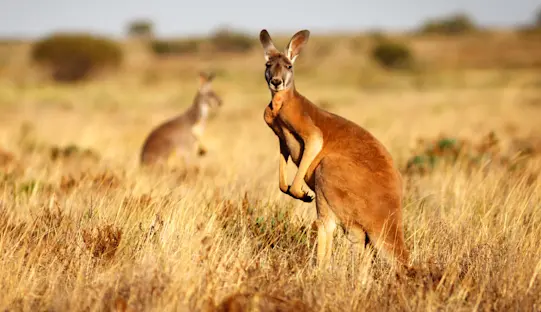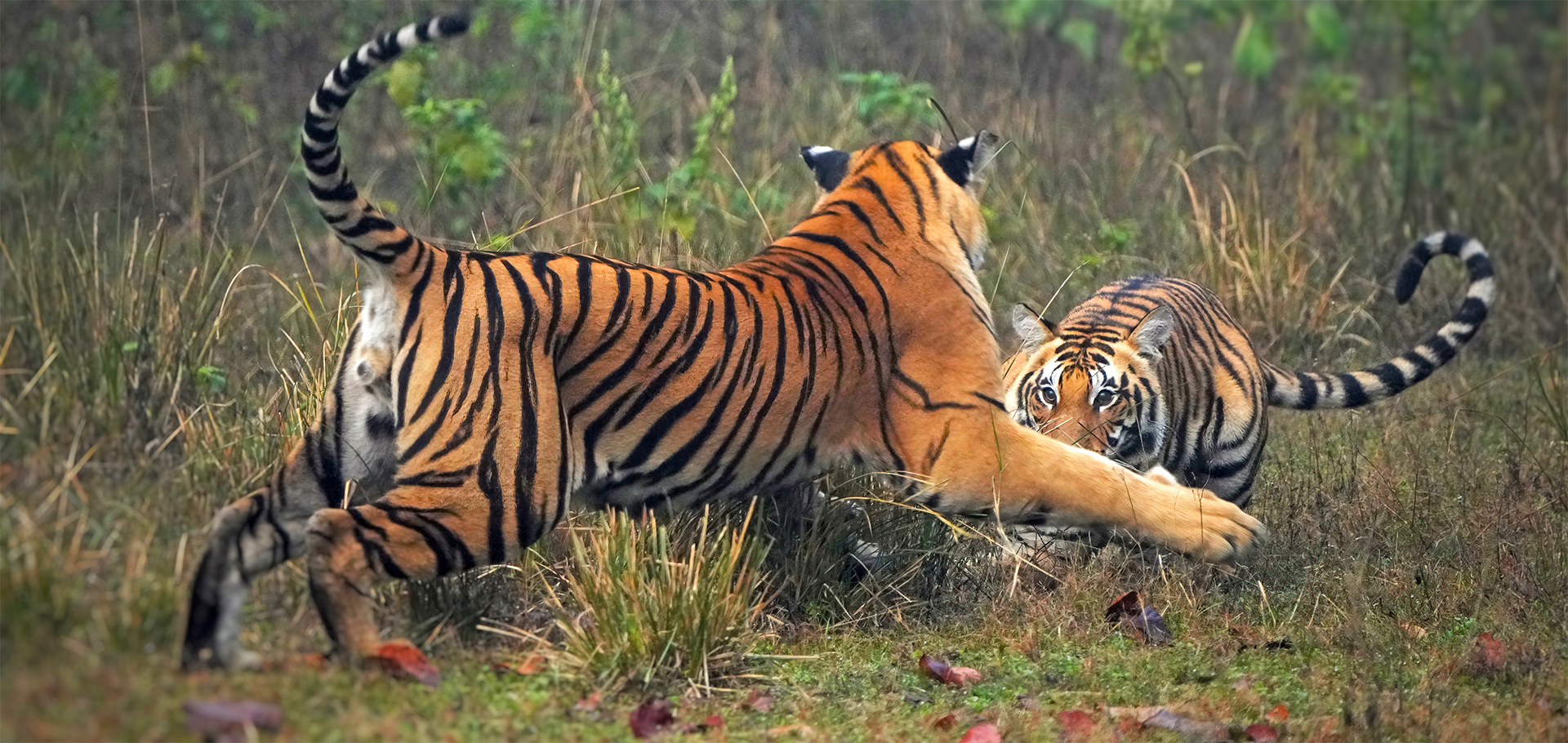The Khata Corridor, a critical 15-mile wildlife passage along the shared border of Nepal’s Bardia National Park and India’s Katarniaghat Wildlife Sanctuary, is a beacon of hope for tiger conservation in South Asia. This vital link, facilitating safe movement for tigers and other wildlife between Nepal and India, underscores the importance of transboundary conservation efforts in preserving biodiversity and enhancing genetic diversity.
Restoration & Adaptation in the Khata Corridor
Two decades ago, the Khata Forest was a degraded landscape ravaged by human encroachment, deforestation, and poaching. The situation was dire, with local communities heavily dependent on forest resources for their livelihoods. The 1950s saw a surge in settlement due to Nepal’s resettlement programs and malaria eradication, further straining the fragile ecosystem. By the 1990s and early 2000s, the forest’s condition had worsened due to widespread encroachment, livestock grazing, and the spread of invasive species.
In response to this crisis, WWF, local communities and the Nepalese government embarked on an ambitious project to restore the Khata Forest. The initiative aimed not only to rehabilitate the ecosystem but also to secure a safe passage for tigers and other wildlife and engage the local community in conservation efforts.

© Surya Ramachandran
Community-Led Conservation: A Blueprint for Success
The cornerstone of this effort was community engagement, transforming the local attitude toward conservation.
WWF’s strategy involved extensive community consultations, awareness programs, and the introduction of sustainable livelihood schemes. These initiatives were designed to reduce the community’s dependence on forest resources, thereby alleviating pressure on the ecosystem.
One of the key components of the Khata Corridor project was the establishment of community forests. Today, a network of 74 community forests covering 78 square miles plays a crucial role in the corridor’s success. These community forests are managed by over 9,000 households, who benefit from sustainable income opportunities and access to irrigation and safe drinking water.
Alternative energy programs were introduced to replace household reliance on firewood, further reducing deforestation. Restoration activities have included the establishment of nurseries, planting native tree species, and allowing forests to regenerate naturally by regulating cattle grazing.
Hear from a local community organizer, homestay host, and a young member of a community anti-poaching unit in WWF-Nepal’s video, Life in Nepal’s Khata Wildlife Corridor.
The transformation of the Khata Corridor has had a profound impact on both wildlife and local communities. The once-degraded forest is now a lush habitat teeming with life. Camera traps have captured images of a wide array of wildlife, including leopards, spotted deer, gray langurs, greater one-horned rhinos, and the critically important Bengal tigers.
Recent data shows an increase in wildlife activity within the Khata Corridor, highlighting its success. This indicates a thriving ecosystem and the effectiveness of the corridor in providing a safe passage for wildlife.
Tigers, a keystone species, play a pivotal role in maintaining the health of the ecosystem. They require large territories to roam and hunt, with an adult male tiger in Nepal needing about 7 to 58 square miles. The Khata Corridor ensures wildlife can move safely between habitats, which is essential for genetic diversity and the overall health of the ecosystem.

© Aditya Panda
The corridor has also been instrumental in the recovery of other species, such as the greater one-horned rhino. Once near extinction, the population has rebounded significantly, thanks to concerted conservation efforts in both India and Nepal. The Khata Corridor’s success in facilitating wildlife movement and supporting biodiversity has earned it recognition as one of the most successful local community initiatives in the larger Terai Arc Landscape.
The resurgence of wildlife in the Khata Corridor has had a positive ripple effect on local conservation travel. Increased wildlife sightings have attracted travelers, providing a sustainable source of income for local communities.
Awareness and securing livelihoods were critical steps in motivating communities for stewardship in conservation.
Celebrating Transborder Conservation Achievements
The Khata Corridor has garnered international acclaim for its conservation achievements. WWF’s efforts have been pivotal in nearly tripling Nepal’s tiger population from 121 in 2009 to 355 in 2022. The corridor’s success in facilitating tiger movement between Bardia National Park and Katarniaghat Wildlife Sanctuary exemplifies the positive impact of well-planned and managed wildlife corridors.
In India, similar conservation efforts have yielded impressive results. The Sathyamangalam Tiger Reserve, for instance, was recognized for doubling its tiger population since 2010. These achievements underscore the effectiveness of dedicated conservation initiatives in reversing the decline of tiger populations and enhancing biodiversity.
The Khata Corridor is a shining example of how transboundary cooperation can lead to significant conservation successes.

© Conan Dumenil
The Broader Terai Arc Landscape (TAL)
Located in the shadows of the Himalayas, the transboundary Terai Arc belt stretches from Nepal’s Bagmati River in the east to India’s Yamuna River in the west, connecting 16 protected areas across both countries. In Nepal, the Terai Arc Landscape (TAL) covers a vast area of 9,540 square miles with a network of six protected areas, forests, agricultural lands and wetlands, with over six million people depending on its forests for food, fuel, and medicine.
A key characteristic of TAL is the presence of eight corridors and two bottlenecks; a landscape conservation approach that facilitates wildlife dispersal between protected areas on either side of this transboundary landscape while also engaging local communities in forest restoration and management.
The Khata Corridor is a crucial component of the larger Terai Arc Landscape, home to a rich diversity of flora and fauna, including tigers, rhinos, leopards, and giant hornbills. This landscape-based approach to conservation aims to protect and connect fragmented habitats, ensuring the long-term survival of wildlife.
Tigers, in particular, benefit from this interconnected landscape. As apex predators, tigers help regulate the populations of prey species, which in turn affects the composition and health of vegetation. By maintaining a balanced ecosystem, tigers contribute to the overall biodiversity and resilience of the region.

© Aditya Panda
Challenges and Future Directions
Despite the successes, the Khata Corridor and the broader TAL face ongoing challenges. Human-wildlife conflict, habitat fragmentation, and climate change continue to threaten the delicate balance of the ecosystem. To address these issues, ongoing efforts are needed to strengthen community engagement, enhance habitat connectivity, and implement adaptive management strategies.
One of the critical areas for future focus is mitigating human-wildlife conflict. As tiger populations recover, interactions between tigers and local communities are likely to increase. Effective conflict mitigation strategies, such as livestock compensation schemes and community-based monitoring, are essential to ensure the continued coexistence of humans and wildlife.
Additionally, climate change poses a significant threat to the region’s biodiversity. Changes in temperature and precipitation patterns can alter habitats and disrupt the availability of resources for wildlife. Adaptive management strategies that incorporate climate resilience into conservation planning are crucial for the long-term sustainability of the Khata Corridor and the TAL.

© Surya Ramachandran
Ensuring the Future of Tiger Conservation in Nepal and India
The Khata Corridor stands as an example of how collaborative conservation efforts can restore degraded landscapes, protect wildlife, and benefit local communities. The success of this transboundary corridor highlights the importance of community engagement, sustainable livelihood programs, and innovative conservation strategies in achieving long-term conservation goals.
As we look to the future, continued support for initiatives like the Khata Corridor is essential. By fostering cooperation between governments, conservation organizations, and local communities, we can ensure that wildlife corridors continue to thrive and provide safe passage for tigers and other species. Together, we can create a world where humans and wildlife coexist in harmony, and the majestic roar of the tiger echoes through the forests of Nepal and India for generations to come.
Explore More: India Tiger Quest + Nepal & Bhutan
Nat Hab continues to support these conservation efforts through their specially curated travel experiences. Our most tiger-intensive itinerary is the India Tiger Quest, which provides participants with the best opportunities to spot and photograph Bengal tigers in their natural habitat.
Nat Hab’s Wild & Ancient Himalaya: Nepal & Bhutan expedition includes rhino tracking in Nepal’s Chitwan National Park, offering a unique glimpse into Nepal’s rich biodiversity. Ideally situated on the edge of the Rapti River, our Chitwan base is in the largest area of undisturbed wilderness along the base of the Himalayas. The surrounding area has a high sighting rate for one-horned rhinoceros, crocodiles and gharial.
Chitwan National Park, established in 1973, is Nepal’s first national park and was named a World Heritage Site by UNESCO in 1984. It covers 360 square miles of subtropical lowlands and is home to about 50 mammal species and more than 500 species of birds. While sightings are never guaranteed, we have good chances to observe rhinoceros, Asian elephants, crocodiles, leopards, sloth bears, sambar deer, wild boar, monkeys and jungle fowl in their natural habitat. This is not a tiger-focused itinerary, but fingers crossed, and conditions permitting, a chance to track tigers might be a special highlight as we join our Expedition Leader and a local guide to search for footprints and pugmarks that mark the tigers’ hidden presence in the park.
Since 2003, Nat Hab has partnered with WWF, the world’s leading environmental organization, to promote this mission. To date, Nat Hab has provided more than $6 million to support WWF’s global conservation efforts and will continue to give 1% of gross sales plus $175,000 annually through 2028 in support of WWF’s mission to conserve nature and reduce the most pressing threats to the diversity of life on Earth. Our travelers have donated an additional $40 million in support of WWF priorities in some of the most precious yet imperiled places on the planet. WWF currently has more than 2,000 conservation projects in progress around the world. Take a look at some of the important work that’s happening in these destinations.
By participating in conservation travel, you not only embark on an unforgettable adventure but also play a vital role in supporting the ongoing efforts to protect our planet’s most vulnerable species. Each journey helps raise awareness and funds essential for the continued success of projects like the Khata Corridor, ensuring that the legacy of conservation endures for future generations.

© Yaju Upadhyaya































